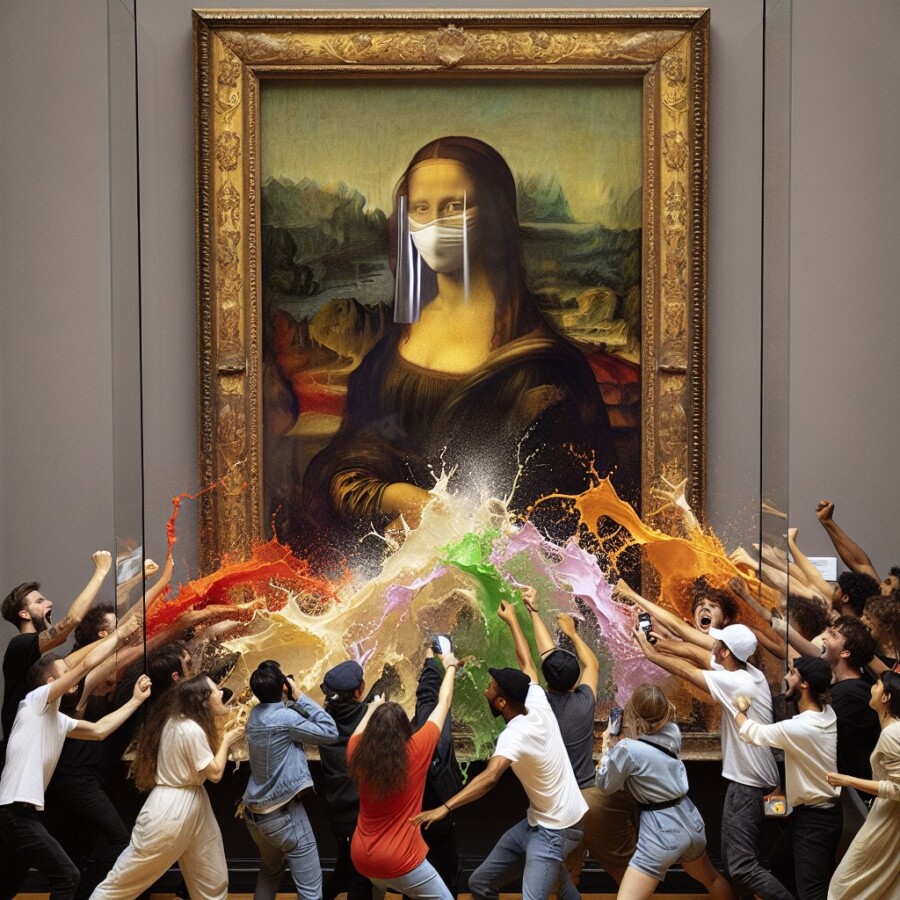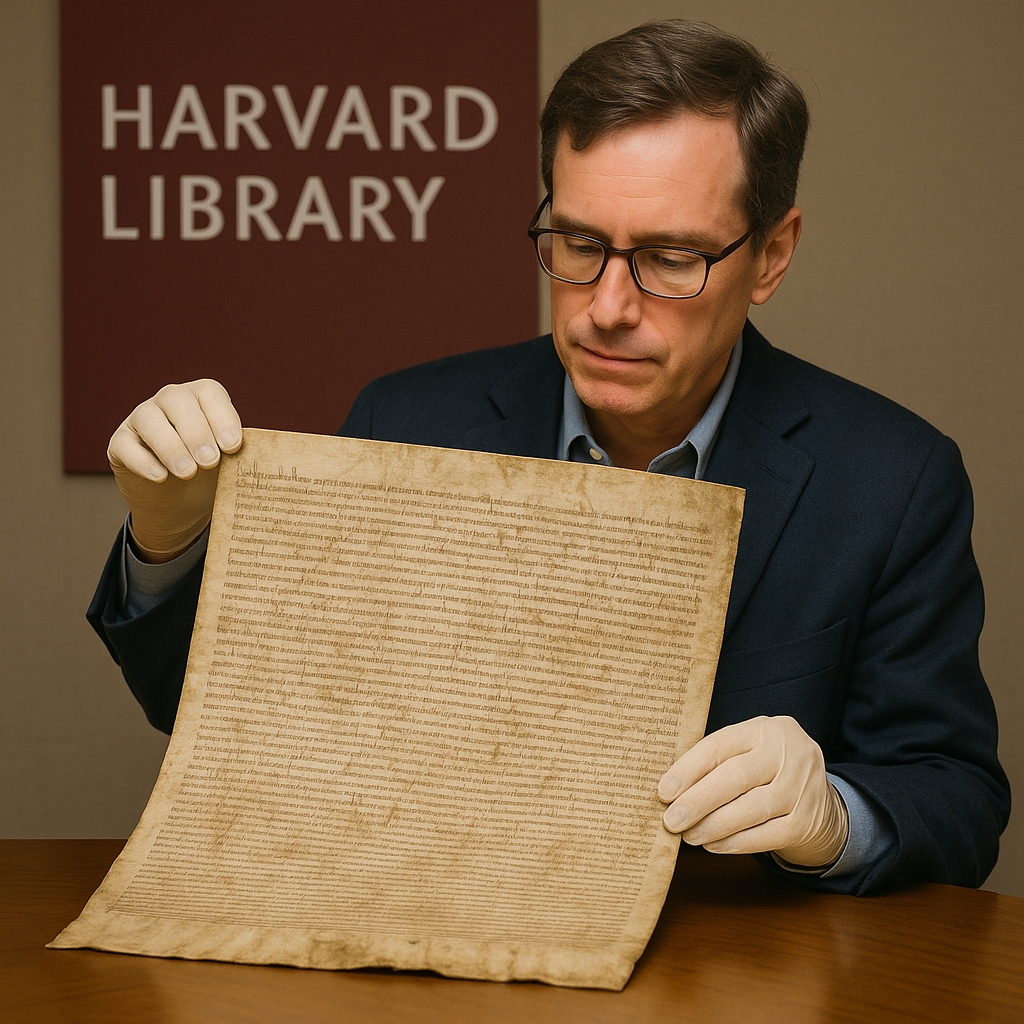Protesters recently caused a stir by throwing soup at the famous Mona Lisa painting in Paris. The 16th-century masterpiece by Leonardo da Vinci is housed in the Louvre, one of the world’s most renowned art museums. Despite the attack, the painting is shielded by bulletproof glass, ensuring its protection from any significant damage.
The demonstrators behind the soup-throwing incident stated that their actions were a call for better access to “healthy and sustainable food,” criticizing the current state of the agricultural system. The protest aimed to draw attention to issues related to food production and distribution, highlighting concerns about the quality and sustainability of the food supply chain.
The Mona Lisa, known for her enigmatic smile, is a symbol of artistic excellence and cultural heritage. The painting’s significance transcends borders and generations, making it a target for those seeking to make a statement through unconventional means. Despite the shock caused by the incident, the painting remains intact and continues to captivate visitors from around the world.
The event underscores the power of art to provoke reactions and spark discussions on important social issues. While the act of throwing soup at a revered artwork may seem extreme, it serves as a reminder of the role art plays in reflecting and challenging societal norms. The incident has sparked debates on the boundaries of protest and the appropriate channels for advocating for change.
As authorities investigate the incident and assess security measures, the Mona Lisa stands as a resilient symbol of artistic expression. The painting’s enduring allure and the controversy surrounding the protest serve as a testament to the enduring impact of art on society and the ongoing dialogue it inspires.
Original news source: Watch: Soup thrown at Mona Lisa painting (BBC)
🎧 Listen:
Slow
Normal
Fast
📖 Vocabulary:
| 1 | protesters | Individuals who actively demonstrate against something they disagree with or want to change |
| 2 | renowned | Widely acknowledged or famous, especially because of excellence in a particular field |
| 3 | masterpiece | A work of outstanding artistry, skill, or workmanship |
| 4 | bulletproof | Resistant to bullets or similar forms of physical damage |
| 5 | significant | Important or noteworthy, with considerable influence or effect |
| 6 | sustainable | Able to be maintained at a certain rate or level without exhausting natural resources or causing severe ecological damage |
| 7 | agricultural | Relating to the science and practice of farming, including cultivation of the soil for growing crops and the rearing of animals to provide food, wool, and other products |
| 8 | distribution | The process by which goods are transported and delivered from one place to another |
| 9 | enigmatic | Difficult to interpret or understand; mysterious |
| 10 | transcends | To go beyond or rise above a limit or norm |
| 11 | unconventional | Differing from what is traditionally done or accepted |
| 12 | captivate | To attract and hold the attention or interest of someone intensely |
| 13 | provoke | To elicit a strong reaction or response, especially by deliberately controversial actions or statements |
| 14 | societal | Relating to or concerned with the structure or affairs of government, people, and communities |
| 15 | resilience | The capacity to recover quickly from difficulties; toughness |
Group or Classroom Activities
Warm-up Activities:
– News Summary
Instructions: In pairs, students will read the article and then summarize the main points in their own words. They should focus on the protest, the reasons behind it, and the impact it had on the painting and society.
– Word Association
Instructions: In groups, students will take turns saying a word that comes to mind when they think of the Mona Lisa and the protest incident. They should try to make connections between the words and discuss their associations.
– Sketch It
Instructions: In pairs, students will take turns describing the Mona Lisa painting to each other. One student will describe the painting while the other tries to sketch it based on the description. Afterward, they can compare the sketch to the actual painting and discuss any differences.
– Opinion Poll
Instructions: In groups, students will create a list of questions related to the protest and the issues it raises about food production and distribution. They will then interview each other and record their classmates’ opinions. Finally, they will present their findings to the class and engage in a discussion.
– Think-Pair-Share
Instructions: Students will individually think about and write down their personal opinions on the protest incident and the role of art in society. They will then pair up with a partner and share their thoughts. Finally, they will share their partner’s thoughts with the rest of the class and engage in a group discussion.
🤔 Comprehension Questions:
1. What was the purpose of the protesters throwing soup at the Mona Lisa?
2. What are the concerns the protesters were trying to highlight through their actions?
3. Why is the Mona Lisa considered a symbol of artistic excellence and cultural heritage?
4. How has the incident sparked debates on the boundaries of protest?
5. What does the article suggest about the power of art to provoke reactions and spark discussions?
6. How does the incident serve as a reminder of the role art plays in society?
7. What is the current state of the Mona Lisa after the soup-throwing incident?
8. How does the controversy surrounding the protest demonstrate the enduring impact of art on society?
Go to answers ⇩
🎧✍️ Listen and Fill in the Gaps:
Protesters recently caused a stir by (1)______ soup at the famous Mona Lisa painting in Paris. The 16th-century masterpiece by Leonardo da Vinci is housed in the Louvre, one of the world’s most renowned art (2)______. Despite the attack, the painting is shielded by bulletproof glass, ensuring its protection from any significant (3)______.
The demonstrators behind the soup-throwing incident stated that their actions were a call for better (4)______ to “healthy and sustainable food,” criticizing the current (5)______ of the agricultural system. The protest aimed to draw attention to issues (6)______ to food production and distribution, highlighting concerns about the quality and sustainability of the food supply chain.
The Mona Lisa, known for her enigmatic smile, is a symbol of artistic excellence and cultural heritage. The painting’s (7)______ transcends (8)______ and generations, making it a target for those seeking to make a statement through unconventional (9)______. Despite the shock caused by the incident, the painting (10)______ intact and continues to captivate visitors from around the world.
The (11)______ underscores the power of art to provoke reactions and spark discussions on important (12)______ issues. While the act of throwing soup at a revered artwork may seem extreme, it serves as a reminder of the role art plays in reflecting and challenging societal (13)______. The incident has sparked (14)______ on the boundaries of protest and the appropriate channels for advocating for change.
As authorities investigate the incident and assess security measures, the Mona Lisa stands as a resilient symbol of artistic expression. The painting’s enduring allure and the controversy surrounding the protest serve as a (15)______ to the enduring (16)______ of art on society and the ongoing dialogue it inspires.
Go to answers ⇩
💬 Discussion Questions:
Students can ask a partner these questions, or discuss them as a group.
1. What do you think about the protesters throwing soup at the Mona Lisa painting?
2. How would you feel if someone vandalized a famous artwork that you love?
3. Do you think it is acceptable to use art as a means of protest? Why or why not?
4. What is the role of art in reflecting and challenging societal norms?
5. How do you think the incident with the Mona Lisa has sparked debates on the boundaries of protest?
6. Do you believe that art has the power to provoke reactions and spark discussions on important social issues? Why or why not?
7. Have you ever participated in a protest or demonstration? If so, what was it about and what was your experience like?
8. How important do you think it is for art museums to have security measures in place to protect valuable artworks?
9. What are some other unconventional ways that people have used art to make a statement?
10. Do you think the protesters’ message about “healthy and sustainable food” was effectively communicated through their action of throwing soup at the Mona Lisa? Why or why not?
11. How do you think the incident with the Mona Lisa has impacted the perception of the protesters’ cause?
12. Have you ever felt strongly enough about an issue to take action or participate in a protest? If so, what was the issue and what did you do?
13. What do you think is the appropriate way to advocate for change in society?
14. Do you think the soup-throwing incident will have any long-term effects on the Mona Lisa’s status as a symbol of artistic excellence and cultural heritage? Why or why not?
15. How do you think the incident with the Mona Lisa has affected the ongoing dialogue about the impact of art on society?
Individual Activities
📖💭 Vocabulary Meanings:
Match each word to its meaning.
Words:
1. protesters
2. renowned
3. masterpiece
4. bulletproof
5. significant
6. sustainable
7. agricultural
8. distribution
9. enigmatic
10. transcends
11. unconventional
12. captivate
13. provoke
14. societal
15. resilience
Meanings:
(A) A work of outstanding artistry, skill, or workmanship
(B) Widely acknowledged or famous, especially because of excellence in a particular field
(C) Resistant to bullets or similar forms of physical damage
(D) Important or noteworthy, with considerable influence or effect
(E) Able to be maintained at a certain rate or level without exhausting natural resources or causing severe ecological damage
(F) Individuals who actively demonstrate against something they disagree with or want to change
(G) To elicit a strong reaction or response, especially by deliberately controversial actions or statements
(H) Differing from what is traditionally done or accepted
(I) Relating to the science and practice of farming, including cultivation of the soil for growing crops and the rearing of animals to provide food, wool, and other products
(J) To attract and hold the attention or interest of someone intensely
(K) To go beyond or rise above a limit or norm
(L) Difficult to interpret or understand; mysterious
(M) Relating to or concerned with the structure or affairs of government, people, and communities
(N) The capacity to recover quickly from difficulties; toughness
(O) The process by which goods are transported and delivered from one place to another
Go to answers ⇩
🔡 Multiple Choice Questions:
1. Who created the Mona Lisa?
(a) Michelangelo
(b) Raphael
(c) Leonardo da Vinci
(d) Vincent Van Gogh
2. Where is the Mona Lisa displayed?
(a) The British Museum
(b) The Metropolitan Museum of Art
(c) The Louvre
(d) The Prado Museum
3. What protected the Mona Lisa from damage during the protest?
(a) Bulletproof glass
(b) A security guard
(c) An alarm system
(d) A plastic cover
4. What was the reason given by the protesters for their actions?
(a) Opposition to museum entrance fees
(b) Demand for more public art spaces
(c) Protest against the commercialization of art
(d) Better access to healthy and sustainable food
5. What century was the Mona Lisa painted in?
(a) 17th century
(b) 16th century
(c) 18th century
(d) 19th century
6. What symbolizes the Mona Lisa in the context of the article?
(a) The struggle for freedom of expression
(b) Artistic excellence and cultural heritage
(c) The impact of digital media on art
(d) The commercialization of historical artworks
7. What does the act of throwing soup at the Mona Lisa aim to highlight, according to the protesters?
(a) The need for more interactive art exhibits
(b) The importance of preserving historical landmarks
(c) The role of art in political movements
(d) Issues related to food production and distribution
8. How did the incident with the Mona Lisa spark discussions?
(a) It highlighted the role of art in societal issues
(b) It raised questions about museum security
(c) It led to a debate on the ethics of restoration
(d) It sparked a conversation on the ownership of art
Go to answers ⇩
🕵️ True or False Questions:
1. The painting is protected by regular glass.
2. The Mona Lisa is a 16th-century masterpiece by Leonardo da Vinci.
3. The Mona Lisa is a symbol of artistic excellence and cultural heritage.
4. The incident sparked debates on the boundaries of protest and advocacy.
5. The protest aimed to draw attention to issues in the food production and distribution system.
6. Protesters threw salad at the Mona Lisa painting in the Louvre in Paris.
7. The demonstrators were advocating for better access to unhealthy and unsustainable food.
8. The painting fails to captivate visitors despite the protest.
Go to answers ⇩
📝 Write a Summary:
Write a summary of this news article in two sentences.
Check your writing now with the best free AI for English writing!
Writing Questions:
Answer the following questions. Write as much as you can for each answer.
Check your answers with our free English writing assistant!
1. What was the motive behind the protesters throwing soup at the Mona Lisa painting?
2. How did the incident highlight concerns about the food supply chain?
3. What does the Mona Lisa symbolize in terms of artistic excellence and cultural heritage?
4. How does the incident demonstrate the power of art to provoke reactions and spark discussions?
5. What debates has the incident sparked regarding the boundaries of protest and advocating for change?
✅ Answers
🤔✅ Comprehension Question Answers:
1. The purpose of the protesters throwing soup at the Mona Lisa was to draw attention to issues related to food production and distribution, specifically calling for better access to healthy and sustainable food.
2. The protesters aimed to highlight concerns about the quality and sustainability of the food supply chain.
3. The Mona Lisa is considered a symbol of artistic excellence and cultural heritage because of its historical significance, its status as a masterpiece by Leonardo da Vinci, and its ability to transcend borders and generations.
4. The incident has sparked debates on the boundaries of protest by raising questions about the appropriateness of unconventional means of making a statement and advocating for change.
5. The article suggests that art has the power to provoke reactions and spark discussions on important social issues.
6. The incident serves as a reminder of the role art plays in society by reflecting and challenging societal norms and by initiating dialogue on various topics.
7. The Mona Lisa remains intact and is protected by bulletproof glass, ensuring its protection from any significant damage.
8. The controversy surrounding the protest demonstrates the enduring impact of art on society by generating discussions and debates on important issues, such as the boundaries of protest and the appropriate channels for advocating for change.
Go back to questions ⇧
🎧✍️✅ Listen and Fill in the Gaps Answers:
(1) throwing
(2) museums
(3) damage
(4) access
(5) state
(6) related
(7) significance
(8) borders
(9) means
(10) remains
(11) event
(12) social
(13) norms
(14) debates
(15) testament
(16) impact
Go back to questions ⇧
📖💭✅ Vocabulary Meanings Answers:
1. protesters
Answer: (F) Individuals who actively demonstrate against something they disagree with or want to change
2. renowned
Answer: (B) Widely acknowledged or famous, especially because of excellence in a particular field
3. masterpiece
Answer: (A) A work of outstanding artistry, skill, or workmanship
4. bulletproof
Answer: (C) Resistant to bullets or similar forms of physical damage
5. significant
Answer: (D) Important or noteworthy, with considerable influence or effect
6. sustainable
Answer: (E) Able to be maintained at a certain rate or level without exhausting natural resources or causing severe ecological damage
7. agricultural
Answer: (I) Relating to the science and practice of farming, including cultivation of the soil for growing crops and the rearing of animals to provide food, wool, and other products
8. distribution
Answer: (O) The process by which goods are transported and delivered from one place to another
9. enigmatic
Answer: (L) Difficult to interpret or understand; mysterious
10. transcends
Answer: (K) To go beyond or rise above a limit or norm
11. unconventional
Answer: (H) Differing from what is traditionally done or accepted
12. captivate
Answer: (J) To attract and hold the attention or interest of someone intensely
13. provoke
Answer: (G) To elicit a strong reaction or response, especially by deliberately controversial actions or statements
14. societal
Answer: (M) Relating to or concerned with the structure or affairs of government, people, and communities
15. resilience
Answer: (N) The capacity to recover quickly from difficulties; toughness
Go back to questions ⇧
🔡✅ Multiple Choice Answers:
1. Who created the Mona Lisa?
Answer: (c) Leonardo da Vinci
2. Where is the Mona Lisa displayed?
Answer: (c) The Louvre
3. What protected the Mona Lisa from damage during the protest?
Answer: (a) Bulletproof glass
4. What was the reason given by the protesters for their actions?
Answer: (d) Better access to healthy and sustainable food
5. What century was the Mona Lisa painted in?
Answer: (b) 16th century
6. What symbolizes the Mona Lisa in the context of the article?
Answer: (b) Artistic excellence and cultural heritage
7. What does the act of throwing soup at the Mona Lisa aim to highlight, according to the protesters?
Answer: (d) Issues related to food production and distribution
8. How did the incident with the Mona Lisa spark discussions?
Answer: (a) It highlighted the role of art in societal issues
Go back to questions ⇧
🕵️✅ True or False Answers:
1. The painting is protected by regular glass. (Answer: False)
2. The Mona Lisa is a 16th-century masterpiece by Leonardo da Vinci. (Answer: True)
3. The Mona Lisa is a symbol of artistic excellence and cultural heritage. (Answer: True)
4. The incident sparked debates on the boundaries of protest and advocacy. (Answer: True)
5. The protest aimed to draw attention to issues in the food production and distribution system. (Answer: True)
6. Protesters threw salad at the Mona Lisa painting in the Louvre in Paris. (Answer: False)
7. The demonstrators were advocating for better access to unhealthy and unsustainable food. (Answer: False)
8. The painting fails to captivate visitors despite the protest. (Answer: False)
Go back to questions ⇧













